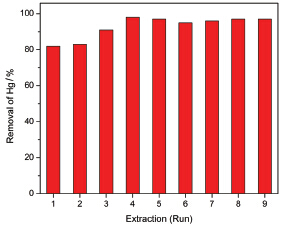| [1] Nolan, E. M.; Lippard, S. J. Chem. Rev. 2008, 108, 3443.
[2] Tchounwou, P. B.; Ayensu, W. K.; Ninashvili, N.; Sutton, D. Environ. Toxicol. 2003, 18, 149.
[3] Nriagu, J. O. Nature 1989, 338, 47.
[4] Onyido, I.; Norris, A. R.; Buncel, E. Chem. Rev. 2004, 104, 5911.
[5] Mureseanu, M.; Reiss, A.; Cioatera, N.; Trandafir, I.; Hulea, V. J. Hazard. Mater. 2010, 182, 197.
[6] Goyal, M.; Bhagat, M.; Dhawan, R. J. Hazard. Mater. 2009, 171, 1009.
[7] Zabihi, M.; Ahmadpour, A.; Asl, A. H. J. Hazard. Mater. 2009, 167, 230.
[8] Liu, J. F.; Zhao, Z. S.; Jiang, G. B. Environ. Sci. Technol. 2008, 42, 6949.
[9] Papaiconomou, N.; Lee, J. M.; Salminen, J.; Von Stosch, M.; Prausnitz, J. M. Ind. Eng. Chem. Res. 2007, 47, 5080.
[10] Germani, R.; Mancini, M. V.; Savelli, G.; Spreti, N. Tetrahedron Lett. 2007, 48, 1767.
[11] Visser, A. E.; Swatloski, R. P.; Reichert, W. M.; Mayton, R.; Sheff, S.; Wierzbicki, A.; Davis, J. H.; Rogers, R. D. Environ. Sci. Technol. 2002, 36, 2523.
[12] Ersoz, M. Adv. Colloid Interface Sci. 2007, 134, 96.
[13] Gao, Z.; Ma, X. Anal. Chim. Acta 2001, 702, 50.
[14] Holbrey, J. D.; Visser, A. E.; Spear, S. K.; Reichert, W. M.; Swatloski, R. P.; Brokera, G. A.; Rogersa, R. D. Green Chem. 2003, 5, 129.
[15] Jin, Z.; Xie, D. X.; Zhang, X. B.; Gong, Y. J.; Tan, W. Anal. Chem. 2012, 84, 4253.
[16] Gkika, E.; Troupis, A.; Hiskia, A.; Papaconstantinou, E. Environ. Sci. Technol. 2005, 39, 4242.
[17] Ribeiro, A. S.; Vieira, M. A.; Willie, S.; Sturgeon, R. E. Anal. Bioanal. Chem. 2007, 388, 849.
[18] Gil, S.; Lavilla, I.; Bendicho, C. Ultrason. Sonochem. 2008, 15, 212.
[19] Liang, L. N.; Jiang, G. B.; Liu, J. F.; Hu, J. T. Anal. Chim. Acta 2003, 477, 131.
[20] Visser, A. E.; Swatloski, R. P.; Griffin, S. T.; Hartman, D. H.; Rogers, R. D. Sep. Sci. Technol. 2001, 36, 785.
[21] Chen, S.; Sun, H.; Zhong, Y.-S. J. Beijing University of Technology 2013, 39, 98. (陈莎, 孙浩, 钟嶷盛, 北京工业大学学报, 2013, 39, 98.)
[22] Rivas, B. L.; Jara, M.; Pereira, E. D. J. Appl. Polym. Sci. 2003, 89, 2852. |
